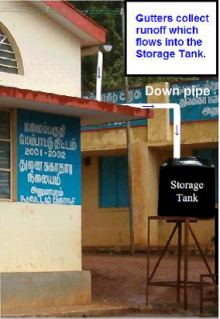If you would like to see more information on this case study, click here!
You can request this case study and a WCDE staff member will get back to you.
 In the Nilgiris District of Southern India, a majority of the rural population does not have access to an adequate supply of water for domestic use. With the groundwater resources showing signs of depletion, the Government of Tamil Nadu has made it mandatory to install rooftop rainwater harvesting (RWH) units on all households within the state. Figure 1 illustrates a typical small-scale rainwater harvesting system. Unfortunately, most rural villages in the region have limited ability to financially support this initiative. Since the largest cost component of the rainwater harvesting structure is the storage unit, careful planning must go into sizing RWH units to ensure the people receive an adequate supply of water, at the lowest possible price.
In the Nilgiris District of Southern India, a majority of the rural population does not have access to an adequate supply of water for domestic use. With the groundwater resources showing signs of depletion, the Government of Tamil Nadu has made it mandatory to install rooftop rainwater harvesting (RWH) units on all households within the state. Figure 1 illustrates a typical small-scale rainwater harvesting system. Unfortunately, most rural villages in the region have limited ability to financially support this initiative. Since the largest cost component of the rainwater harvesting structure is the storage unit, careful planning must go into sizing RWH units to ensure the people receive an adequate supply of water, at the lowest possible price.
Dan Olsen, an intern with Engineers Without Borders, created this case study based on his experience in India and while completing his master’s degree at McMaster University.
This case study is intended to illustrate the design process and the effective use of simple models, using Excel, in the solution of engineering design problems. The social context of engineering is also highlighted.
If you would like to see more information on this case study, click here!
You can request this case study and a WCDE staff member will get back to you.
Contact Waterloo Cases in Design Engineering
Steve Lambert
Tel: (519) 888-4728
Email: steve@uwaterloo.ca
The University of Waterloo acknowledges that much of our work takes place on the traditional territory of the Neutral, Anishinaabeg and Haudenosaunee peoples. Our main campus is situated on the Haldimand Tract, the land granted to the Six Nations that includes six miles on each side of the Grand River. Our active work toward reconciliation takes place across our campuses through research, learning, teaching, and community building, and is co-ordinated within the Office of Indigenous Relations.